创新在这家公司野蛮生长,全靠古怪的CEO
|
创新就像创意一样,没有一定之规。创新乃企业发展关键,但实现起来,甚至只是清晰解释起来都很困难。 在创新方面,Salesforce是个例外。虽然其产品不过是工作效率工具,但这家公司已将创新融入企业的血液。不管是业务上,销售上,还是阐述公司使命时,处处有创新的影子。 Salesforce的联合创始人兼首席执行官马克·贝尼奥夫现年53岁,问他企业如何实现创新时好像让传奇男高音多明戈唱几段最喜欢的咏叹调一样。稍微开个头,贝尼奥夫就开始口若悬河说起Salesforce创立近二十年来领先行业的三大秘诀。“我认为最重要有三点,一是抓住了新技术模式,即现在众所周知的云技术;二是认购的商业模式;三是1-1-1模式,”他表示,最后一条指的是企业的慈善承诺,即捐出1%的股份、产品和员工服务时间。 这些观念现在已经广为应用,但只是开始。贝尼奥夫常会冒出一些古怪、执拗,常常剑走偏锋的招数,Salesforce在企业(非消费者)科技领域还常是产品推广者。该公司向来擅长预测并引领技术变革,最近的动向是投身人工智能领域。Salesforce在财会领域也有创新之举,曾苦战数年说服标准委员会和监管者接受其收入和支出确认方式。 |
Innovation, like creativity, is an amorphous concept. It’s the holy grail of business, but achieving it—even merely explaining it—is lightning-in-a-bottle difficult. In that way, Salesforce (CRM, +0.79%) is a major outlier. Despite the fact that its products are mundane business productivity tools, Salesforce has nevertheless managed to bake innovation into its very corporate fiber. It’s a company that was innovative in the way it started doing business, in how it sold its products, and in the articulation of its corporate mission. Indeed, asking cofounder and CEO Marc Benioff, 53, to describe how Salesforce is innovative is a bit like asking Plácido Domingo to hum a few bars of a favorite aria. With little provocation Benioff will rattle off the three ways Salesforce has been a trailblazer since its inception nearly two decades ago. “I think our top three are a ¬technology model which is now known as the cloud, the subscription business model, and our 1-1-1 model,” he says, referring to the company’s philanthropic ¬commitment to give away 1% each of equity, products, and employee hours. These now widely copied practices are merely the beginning. Under Benioff’s quirky, obsessive, and dripping-with-chutzpah tactics, Salesforce is as original a product marketer as exists in enterprise (or nonconsumer) technology. It has proved adept at predicting and embracing technology shifts, the latest being an aggressive move into artificial intelligence. Salesforce even innovates in the realm of financial accounting, having waged a multi¬year battle to persuade standards boards and regulators to adopt its methods of revenue and expense recognition. |
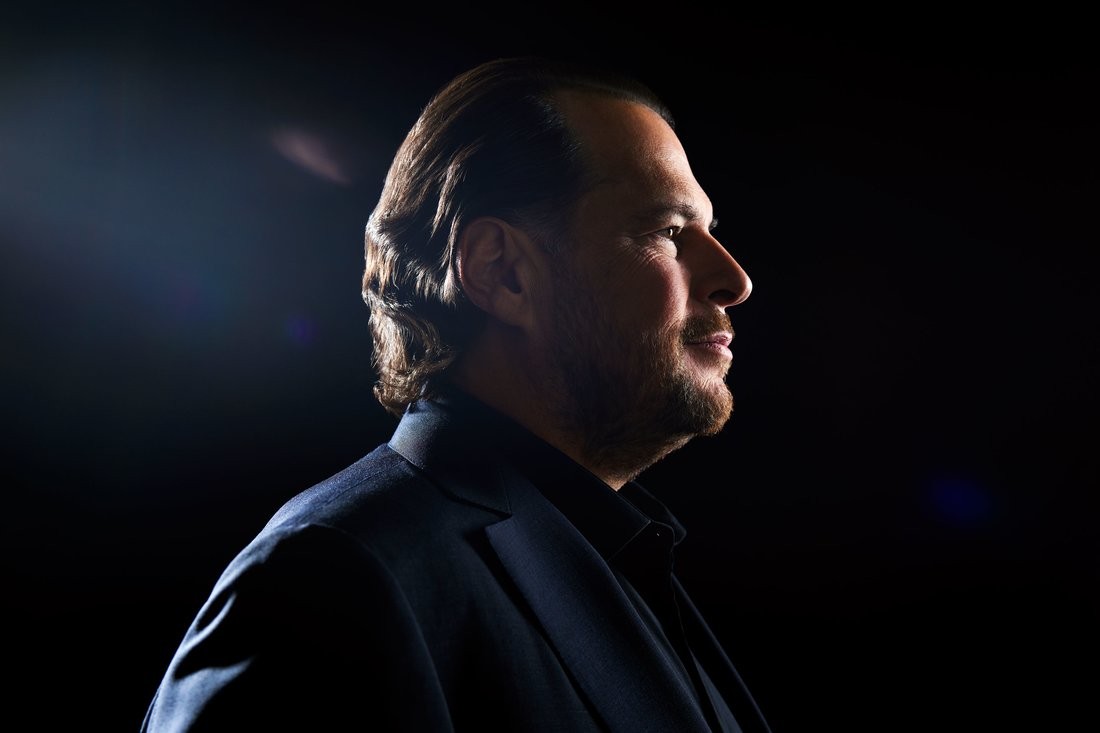
|
之所以《财富》首次发布美国创新企业50强榜单中,Salesforce能独占鳌头(在市值超过200亿美元以上“领头”企业中排名第一)。据波士顿咨询公司分析,Salesforce获胜有多种因素作用,包括华尔街对未来增长的预期,也包括其公开宣布的未来发展目标。 当然了,创新也有局限性,不过Salesforce同样擅长通过并购推动进一步增长,其前辈对手们例如甲骨文和SAP对这招也非常熟悉。Salesforce收购的公司通常分两种,要么特别擅长创新,要么就是在Salesforce尚未打入的市场中占一席之地。2006年以来,Salesforce已经收购了55家公司。 Salesforce采用的模式也有很多风险,对贝尼奥夫的强烈依赖堪称第一位。虽然公司里管理层人数众多,但老大的位置无人能撼动。所有重要决策都由他来做,可以说,全公司28000多人有时会为他又善变又任性的念头忙得团团转。 贝尼奥夫曾萌生退意,因此其重要的地位愈加成为问题,两年前他就差点把公司卖给微软。(没签实质协议。)贝尼奥夫自己也不否认总有一天会退下首席执行官的位子。有人问他会不会在该岗位再做30年,他提起很多社会层次的重要原因:“我觉得时间不算特别长,因为我真的感觉世界需要我。当今世界面临的挑战远胜从前。”贝尼奥夫表示经营Salesforce花的时间占了95%的时间,“剩下5%做很多真正重要的事情。我相信总有一天社会变革的程度会更大一些,我希望能花更多时间亲自去做重要的事。” 但贝尼奥夫并没打算就此打住Salesforce发展的步伐,毕竟还有很多潜在顾客等着拓展。 Salesforce的员工对自家产品和本公司都充满热情,他们几乎相信如果不是公司产品用户基本不可能了解。不过至少旧金山很了解贝尼奥夫和Salesforce多么慷慨:这位首席执行官和公司已捐出上亿美元,资助学校、医院,还有各种善举。旧金山人也都知道Salesforce大厦,1070英尺高的摩天大楼很快就会完工,届时将成旧金山最高建筑,现在从城外都能清楚看到。 |
These accomplishments help explain why Salesforce has landed atop the inaugural Fortune Future 50 list of innovative U.S. companies (ranked No. 1 on the “Leaders” list of corporations with a market value above $20 billion). Based on analysis by BCG, Salesforce earns its ranking from a variety of factors including Wall Street’s expectations of future growth and public messaging that communicates a future-focused orientation. Innovation has its limits, of course, and Salesforce has proved adept at supplementing its growth with acquisitions, a tool long available to older rivals like Oracle (ORCL, -0.46%) and SAP. Salesforce acquires companies—it has snapped up 55 since 2006—that are either more innovative or that have pioneered market segments that Salesforce hasn’t yet cracked. There are plenty of risks to the Salesforce model—with Benioff’s indispensability topping the list. Though the company has a deep management bench, no one disputes the top dog’s singular role. All major decisions are his, and the entire 28,000-person-plus organization caters to his sometimes capricious whims. Benioff’s outsize role would be less of an issue if he hadn’t already signaled a willingness to let go, namely, his flirtation with selling the company to Microsoft two years ago. (No deal materialized.) Benioff himself doesn’t discount the possibility that he’ll step down as CEO one day. Asked the likelihood of his being in the top job for another 30 years, he says, in reference to the many social causes he champions: “I don’t think it’s very high, because I really feel the pull of the world on me. The world has more challenges than ever.” Benioff says he spends 95% of his time on Salesforce, and “5% is on a lot of the issues and things that are really important to me. I think at some point that will shift a little bit more where I’ll want to spend more time directly working on those causes.” But Benioff isn’t quite ready to call it a day at Salesforce. There are still too many potential customers to woo. Salesforce employees are so immersed in the fervor over their offerings and their unique workplace that they are nearly incredulous to learn that few people beyond the legions of customers using Salesforce’s product have the faintest idea what the company does. San Franciscans, at least, are well aware of Benioff’s personal largesse and Salesforce’s corporate generosity: Together, the CEO and his company have given away hundreds of millions of dollars to fund schools, hospitals, and a myriad of causes. And they certainly know about Salesforce Tower, the soon-to-be-completed 1,070-foot skyscraper that will be San Francisco’s tallest and is already visible for miles outside the city. |

|
至于产品,Salesforce刚起家时主要卖应用,可帮助销售人员跟踪客户,管理者也能用来判断进展。之前此类产品已经存在,Salesforce创新之处在于将产品放在网上,客户可以按月付款。买家的技术成本由此降低,还避免了购买不合适的软件。随后Salesforce为客服部门、推广人员,以及在线出售产品和服务的企业开发或收购软件。其实卖的都是企业不可或缺的工具,只是更适应数字时代。“他们抢占了现有市场,将原有业务变得比较酷,”多年来长期观察Salesforce的投资公司杰富瑞分析师布伦特·提尔表示。 Salesforce作为企业动作非常迅速,迅速由传统的软件提供商转向“企业界”,即大企业客户,以往企业层面升级产品要花上数年。“我们每四个月就提供升级版,” Salesforce首席产品官亚力克斯·达杨表示。这意味着每家企业客户总能用上最新版的软件,行业水准由此提升,过去都是打包出售软件且极少提供升级服务。“这是我们成功的秘诀,”达杨表示。他是法国人,九年前因Salesforce的收购加入公司。“其他公司都做不到为数亿用户提供一年三次升级。” Salesforce另一个特点是激进的市场推广策略,从刚成立就如此。帕克·哈里斯担任首席技术官兼联合创始人,他回想起公司刚开始推出“终结软件”的推广活动,其实是巧妙偷换了概念,因为Salesforce把软件当成服务卖,而不再是打包出售,也就是说,卖的不再是单纯软件。Salesforce聘请演员假装在竞争对手举办的论坛上提出抗议。也有潜在客户对Salesforce提出质疑,称之同样是出手软件,只不过形式不同。“当时我们的策略成功了,因为他们已经开始跟我们讨论起设置好的话题,”哈里斯表示。 |
As for its products, Salesforce started with an application that helps salespeople track their clients and their managers measure their progress. That sort of thing had existed, but Salesforce innovated by putting its product online and letting customers pay by the month. This lowered technology costs for buyers and also diminished the risk of purchasing the wrong software. Over time the company built or acquired applications for customer-service workers, marketers, and companies who sell goods and services online. It’s all the nuts-and-bolts stuff of business, but configured for the Digital Age. “They took existing markets and made them cool,” says Brent Thill, a research analyst with the investment firm Jefferies who followed Salesforce for years. As a company, Salesforce moves fast, a shift from the traditional providers of software to “enterprises,” or big-business customers, whose product updates typically were measured in years. “We ship a new version every four months,” says Alex Dayon, the company’s chief product officer. This means every customer always is using the latest version of the software, a high bar in an industry used to a patchwork quilt of software generations and sporadic updates. “It’s our secret sauce,” says Dayon, a Frenchman who joined Salesforce in an acquisition nine years ago. “No one else can update hundreds of millions of users three times a year.” Another crucial part of Salesforce’s formula is aggressive marketing, which it has been doing since its inception. Parker Harris, the company’s chief technology officer and a cofounder, recalls the company’s introductory “end of software” marketing campaign, an elaborate misdirection stunt suggesting that because Salesforce was selling software as a service rather than in a package, it wasn’t selling software at all. The company hired actors to stage fake protests at conferences hosted by a competitor. Prospective customers challenged Salesforce, arguing that it, too, sold software but in a different format. “At that point we had them, because we had engaged them in the conversation,” says Harris. |

|
Salesforce在推广上大手笔花钱,对自身也产生影响。好几年都是净亏损。但该策略推动公司迅速发展。举个例子,长期以来贝尼奥夫非常推崇德国商业学者克劳斯·施瓦布,施瓦布创立了世界经济论坛,还曾协助推广商业界的“利益相关者”理论,即企业要成功不能只重视股东。贝尼奥夫对施瓦布的理念很感兴趣,花费数百万美元成为施瓦布举办论坛的重要合作伙伴。结果是Salesforce四两拨千斤地打入了极具影响力的国际组织,跻身“思想领导者”行列,也由此获得诸多知名企业青眼并收获不少高端订单,原本一家创立不久的公司是不可能做到的。 对主营非消费者技术的企业来说,劝服客户使用自己的软件,以及培训的过程都比较困难。Salesforce用的法子比较非主流。Salesforce每年在旧金山举办奢华的“梦想力量开发者论坛”,除了提供各种软件教程,还会请来魔术师或摇滚明星助阵。 最近Salesforce又有新举措,涉及了一套全新的词汇为用户提供培训,贝尼奥夫称之为“设计语汇”。负责开发者关系的萨拉·富兰克林表示,挑战在于“如何推动所有人顺利了解我们的思路?”解决方案是一套详尽的在线培训系统,灵感来自美国国家公园系统,由一群深信边玩边学更有效率的员工开发,她对此赞不绝口。富兰克林将该系统称为“登山口”,而系统的用户,也是Salesforce最看重的客户们都是“探路者”。 |
The lavish spending on marketing has an impact on Salesforce’s bottom line. For years it rang up net losses. But the tactics also have fueled the company’s growth. As an example, Benioff has been a longtime acolyte of Klaus Schwab, the German business academic who founded the World Economic Forum and helped popularize the “stakeholder” theory of business, that shareholders aren’t the only constituency that matters for business success. Schwab’s ideals appealed to Benioff, who proceeded to spend many millions of dollars to become a key partner of Schwab’s forum. The result: Salesforce punched way above its weight in “thought leadership” in the influential global organization, a status that opened doors for sales to the kinds of companies that were otherwise reluctant to buy from an unproven upstart. Persuading customers to use their software—as well as teaching them how—is often a challenge for nonconsumer technology companies. Salesforce takes a predictably unconventional approach. It spends extravagantly on its annual Dreamforce developers conference in San Francisco, an event that is as likely to include a performance by a magician or rock star as its many software tutorials. Yet Salesforce has topped itself recently by designing a whole new “design vocabulary,” as Benioff calls it, for educating users. The challenge, says Sarah Franklin, who heads developer relations, is, “How do you skill everyone up on what we do?” The solution, which she credits to a game-happy “evangelist” on her staff, was to create an elaborate online training program that draws inspiration from the U.S. national park system. Franklin called the program “Trailhead,” and the people who use it, Salesforce’s cherished customers, “Trailblazers.” |
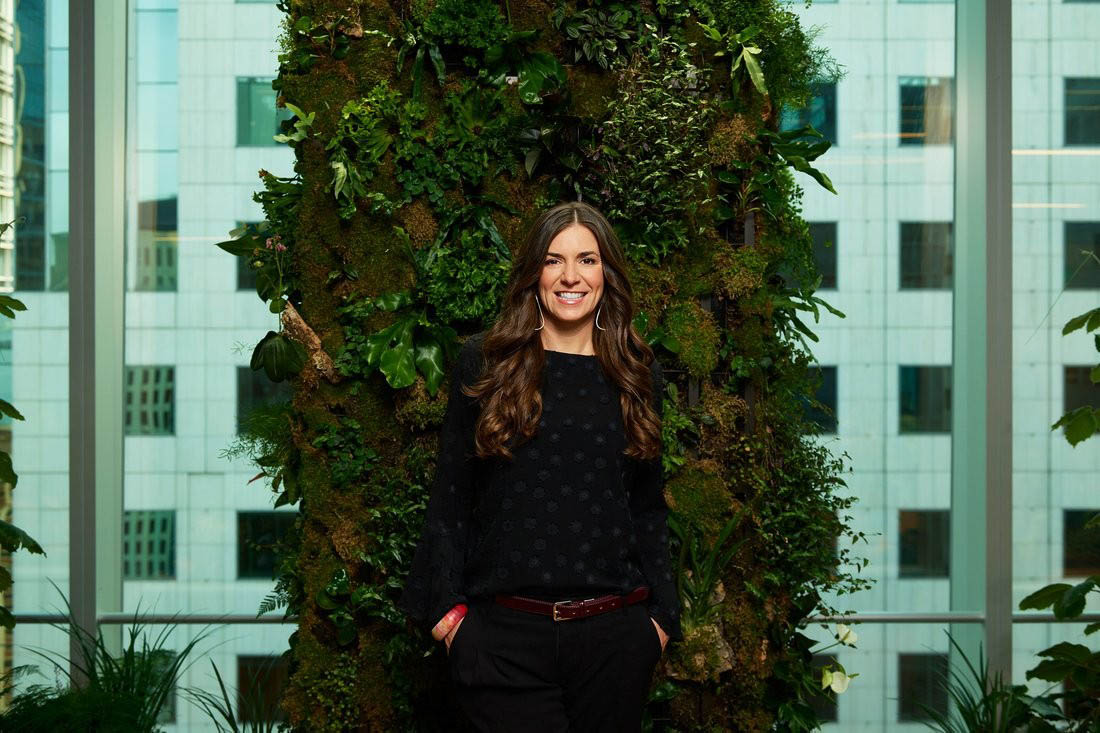
|
虽然说起来有点夸张,但该系统确实做到了鼓励大批用户和开发者争取勋章,证明自己完成了培训课程,迄今约有50万人参与。富兰克林表示她是在跟贝尼奥夫谈话之后想到了这个项目,虽然代价不菲,但有效改变了公司的公共形象和感觉。谈完的当天晚上她翻来覆去睡不着,连夜爬起来打电话,还写了这款产品的说明,然后发给了贝尼奥夫。早上她收到回信,“没问题。Aloha(夏威夷语的问好),马克。” 贝尼奥夫和家人特别喜欢待在夏威夷岛上。所以Salesforce每座主要建筑里都有负责营造社区空间的“Ohana”层,在夏威夷语里意思是家庭,贝尼奥夫希望Salesforce每位员工、客户和合伙人都能感觉身处同一个大家庭里。因此Salesforce也得按照“夏威夷时间”(夏威夷与加州属不同时区——译者注)办公,至少需要贝尼奥夫参与时经常是。不管是要见贝尼奥夫还是会见结束都要看他的时间。 |
It’s all a bit hokey but nonetheless effective in persuading customers and developers—some 500,000 of whom have given it a try so far—to earn badges signifying completed training classes. Franklin says she conceived of the program, which at great expense would change the entire look and feel of the company’s public profile, after a conversation with Benioff. Unable to sleep that night, she picked up her phone and typed a manifesto, which she sent to Benioff. In the morning he replied, “Approved. Aloha, Marc.” Benioff and his family spend as much time as they can on the Big Island of -Hawaii. Each major Salesforce building has an “Ohana” floor, a community space named for the Hawaiian word for family, which Benioff wants every Salesforce employee, customer, and partner to feel a part of. It is fitting, then, that at least where the CEO is concerned, Salesforce operates on a corporate version of “island time.” Meetings with Benioff start and end whenever he’s ready. |
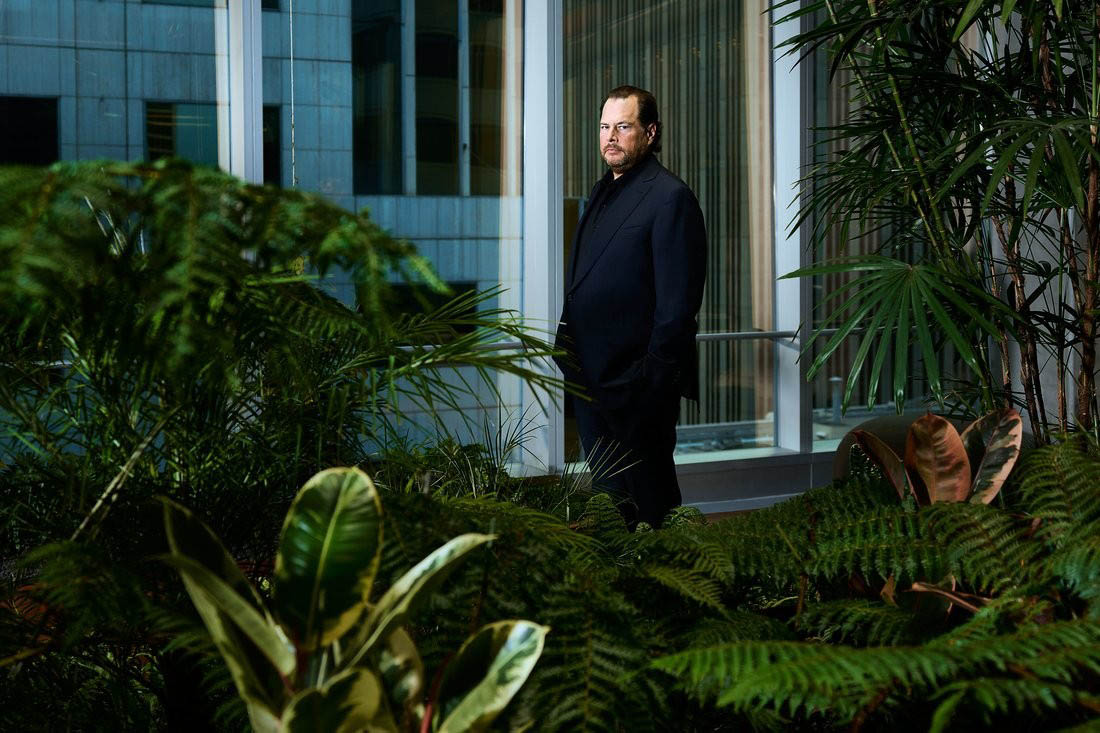
|
我采访他第一天就发现了这点。(身为旧金山人,我对贝尼奥夫的大名并不陌生。)当天我要跟贝尼奥夫参观即将完工的Salesforce大厦,可以从玻璃还没装好 62层楼上俯瞰整个湾区,但得提前90分钟到。结果参观时他根本没现身,随后后来在街对面另一座Salesforce办公楼里共进了午餐。我们一坐下就明显感受到,所有的时间都由他掌控。他给我过了一遍两个月后将在“梦想力量论坛”上发表的演讲草稿。我看着他调整用词,身边的雷安德罗·佩雷兹不停记下新改动的地方。(佩雷兹公开职务是“企业讯息和内容”,他表示,“要确保管理层向外界发出的信息与马克的思路一致。”) 如果算上贝尼奥夫自己的修改,这份演讲稿已经是第86版,最后定稿可能是第150版。内容涉及公司所有关键信息,包括核心价值(信任、增长、创新、平等),解释了公司历史中的“三大篇章”:云业务(1999-2009),客户(2009–2017),以及人工智能(2018–)。 我连一个问题都没来及问,采访时间就结束了。 一个星期后,贝尼奥夫在夏威夷休了个长周末,然后给我打了FaceTime视频电话,这次他很耐心地让我主导了谈话。交谈中他对Salesforce取得的成就非常自豪,他将长期管理公司的乔·阿兰森成为“云业务的幕后英雄”,因为他说服会计标准委员会允许销售佣金延后确认,虽然概念比较晦涩,但对采用订购模式的软件公司在账目中更准确地反应财务情况来说至关重要。贝尼奥夫还指出已有3000家公司采用了Salesforce的1-1-1慈善模式。他还向亚马逊致敬,Salesforce对追求客户体验的灵感就来自亚马逊。他毫不讳言地承认Salesforce最初页面模仿了亚马逊的用户页面。他表示,目标是“打造看起来、感觉上、言行上都像亚马逊的企业级应用,因为亚马逊从来不用培训任何人使用网站,我们也要打造同样体验的软件,不能像现在难用的企业软件一样。” 虽然贝尼奥夫行事自成一派,但也承认受到一系列影响。从施瓦布身上,他学到了与股东不一样的“利益相关者”概念。他的第一任老板拉里·艾力森帮助他见识到新创意的价值,虽然“为拉里工作有时像打心理战”。此外他还向一位自我成长大师学习勤学好问:“我的朋友托尼·罗宾斯说,生命的质量取决于问题的质量。” 到最后,或许贝尼奥夫最看重的还是自己的直觉。Salesforce的工程师都不理解他为何看重社交媒体,尤其不理解为何他下令为Salesforce的应用开发内部通讯软件Chatter。最后工程师还是研发成功,此举也为Salesforce赢得了重视客户需要的美名。 |
I learn this firsthand on the day I arrive to interview him. (As a fellow San Franciscan, I’ve known Benioff for years.) I’d been invited to arrive 90 minutes early to tour the nearly completed Salesforce Tower with Benioff—a thrilling opportunity to view the Bay Area from the 62nd floor of a building whose windows haven’t yet been installed. He didn’t show up for the tour, though we did have lunch across the street at another Salesforce building afterward. When we finally sit down, it’s clear the agenda is his, not mine. He takes me through the working-document version of the keynote presentation he’ll give at Dreamforce in about two months. I see how Benioff hones his message, trying out lines as Leandro Perez, a product marketing executive, takes notes on Benioff’s riffs. (Perez, whose official role is “corporate messaging and content,” says: “We make sure our executives are spreading the message consistent with Marc’s.”) Taking into account Benioff’s tweaks, this is the 86th version of the presentation, on its way to about 150 in total. It hits all the company’s key messages including its core values (trust, growth, innovation, and equality) and explains the three “chapters” of the company’s history: the cloud (1999–2009), the customer (2009–2017), and the Age of Intelligence (2018–). We run out of time before I get to ask a single question. A week later Benioff FaceTimes me from Hawaii, where he’s taken a long weekend, and patiently allows me to direct the flow of the conversation. He proudly reflects on Salesforce’s accomplishments. He calls Joe Allanson, the company’s longtime controller, “the cloud industry’s unsung hero” for working with accounting standards boards to allow for the deferred recognition of sales commissions—an arcane but important maneuver that enables subscription-model software companies to more accurately reflect the reality of their finances in their accounting. Benioff notes that 3,000 companies have adopted Salesforce’s 1-1-1 philanthropic model. He also pays homage to Amazon, an early inspiration for the type of consumer experience Salesforce aims to deliver. He unabashedly notes that Salesforce’s earliest versions were copies of Amazon’s user interface. The goal, he says, was to “build an enterprise app that looks, feels, talks, and walks like Amazon, because they are not training anybody to use their website, and we want to build software that’s not going to be like the current generation of enterprise software.” Benioff is as sui generis as they come, yet he credits a diverse set of influences. From Schwab, he took the concept of “stakeholders” as opposed to only shareholders. Larry Ellison, his first boss, motivated Benioff by helping him see the value of new ideas, even if “working for Larry was at times psychological warfare.” And he has learned the value of being inquisitive from a guru of self-improvement: “My friend Tony Robbins says the quality of your life is created by the quality of your questions.” More than anything, perhaps, Benioff values his own intuition. Salesforce engineers didn’t understand his devotion to social media, especially when he asked them to create Chatter, an in-house messaging tool for Salesforce’s applications. They complied, though, and the move gave Salesforce a consumer-oriented edge. |

|
与之类似,贝尼奥夫解释为何转向人工智能时表示,他发现“人工智能领域发生很多事,但并没有想清楚Salesforce在人工智能领域可以做什么。所以我们开始收购很多人工智能企业,可能会买十几家。”贝尼奥夫还表示,Einstein.com网站站长也突然联系他,要把网站卖给他。这像某种讯号。“从那时起我经常问自己,‘为什么会有人这么做?’直觉告诉我:‘这有可能变成我们在人工智能领域的品牌。’”如今Einstein已成为Salesforce旗下产品,负责在公司其他业务中结合机器学习和其他人工智能领域的技术。 Salesforce独特之处很多,其中有一点经常引发内外部争议。随着不断发展,公司愈变得《圣经》里的巨人歌利亚,而之前Salesforce一直更像成功杀掉歌利亚的英雄大卫,换句话说,越来越像拉里·艾力森创办的甲骨文。Salesforce跟甲骨文一样变成了收购机器,一些人质疑其为了弥补短处乱花很多钱。“我听到投资者问最多的问题是,‘这家公司是当代甲骨文么?’”分析师布伦特·提尔说。“还有人问‘能不能不靠收购实现增长?’”(去年贝尼奥夫先是跟微软争夺领英,又尝试收购推特,让投资者很不高兴。后来他放弃了推特,也没收购成领英。) |
Similarly, Benioff explains the company’s move into artificial intelligence as his realization that “a lot was happening in A.I. But I also realized it wasn’t clear what Salesforce’s role in A.I. was. That’s when we started acquiring quite a few artificial intelligence companies, maybe a dozen.” That’s also when, according to Benioff, the owner of the website Einstein.com contacted him out of the blue and offered to sell it. To Benioff, it was a sign. “Right then I’ll always say to myself, ‘Why is somebody doing that?’ And then I’ll have an intuitive response: ‘This could be our A.I. brand.’ ” Today, Einstein is the Salesforce-branded product that’s integrating machine learning and other A.I.-related technologies into the rest of the company’s offerings. For all of Salesforce’s uniqueness, a nagging criticism has crept up internally and externally. As the company grows, it begins to look and act ever so slightly more like the Goliath to which Salesforce has always played David: Larry Ellison’s Oracle. Like Oracle, Salesforce has become an acquisitions machine, prompting some to suggest the company overpays to make up for its own shortcomings. “The question I hear most from investors is, ‘Is this the modern-day Oracle?’ ” says Brent Thill, the analyst. “ ‘Can they grow without acquisitions?’ ” (Investors weren’t pleased last year when Benioff explored buying Twitter after bidding against Microsoft for LinkedIn. He backed off on the former and lost out on the latter.) |
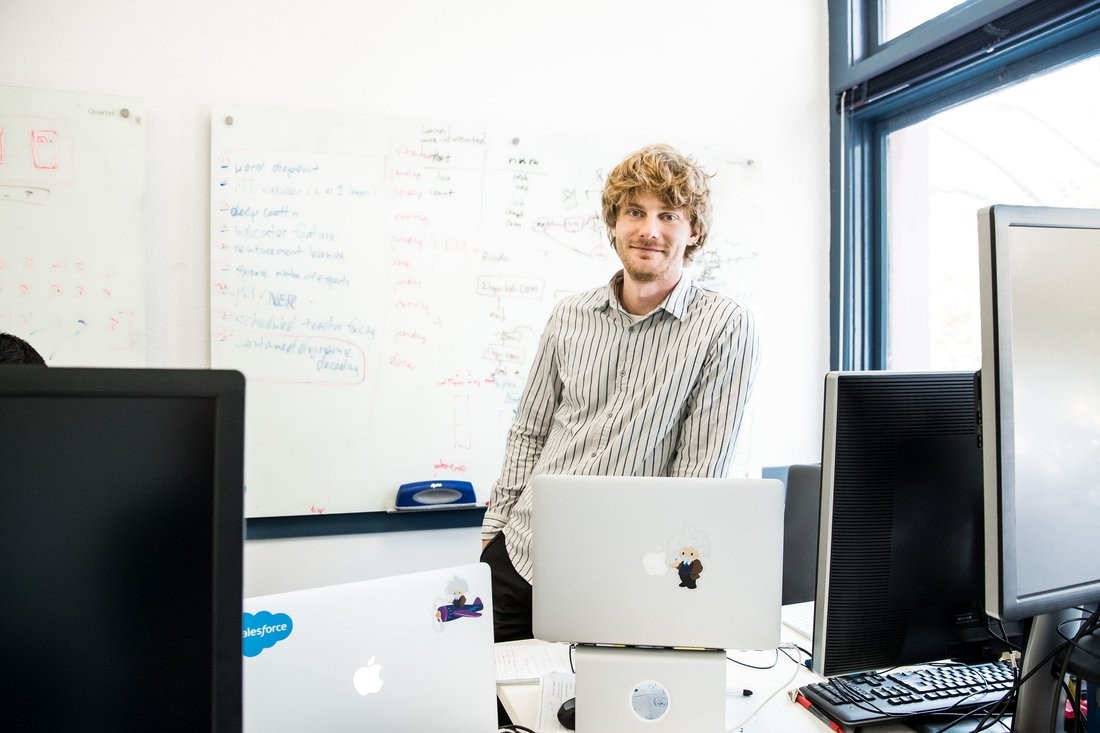
|
Salesforce变得像甲骨文是从董事长、副总裁兼首席运营官吉斯·布洛克开始的,四年前他加入Salesforce,之前担任甲骨文销售总裁,在甲骨文工作了26年。从很多角度来看,布洛克较守陈规,仿佛太极中的阴,而贝尼奥夫穿T恤在夏威夷休假的不拘小节仿佛太极中的阳,二人合作可以实现中和。布洛克曾在管理咨询公司博思艾伦工作过,但他明确表示Salesforce跟之前了解的公司都不一样。“我们不会受服务器和存储影响,”他表示,暗指甲骨文。“我们也不会分心去想游戏,”他补充道,说的是微软的XBOX业务。 然而Salesforce的合作伙伴对之既尊敬又畏惧,几乎不可避免。任何收入达到100亿美元的企业都不可能不树敌。“Salesforce就像温和版的亚马逊,”一位投资了Salesforce竞争对手的风投资本家表示。关于Salesforce冷血收购堪比亚马逊的例子很多。举个例子,Salesforce曾经抛开曾经的合作伙伴Marketo,转而收购ExactTarget,其产品线包括Pardot,是Marketo的直接竞争者。类似例子还有Salesforce曾经的重要合作伙伴——专注定价软件的创业公司Apttus,内部的企业风投基金还投了资,但后来Salesforce还是收购了其竞争对手SteelBrick。 |
The seeming proof of Salesforce’s incipient Oracle-ness is the presence of president, vice chairman, and chief operating officer Keith Block, a 26-year veteran Oracle sales executive before joining Salesforce four years ago. In many ways the buttoned-down yin to Benioff’s Hawaiian-shirt-wearing yang, Block says Salesforce isn’t like any other company he’s seen, including during his days as a Booz Allen management consultant. “We’re not diluted by servers and storage,” he says, a knock on Oracle. “We’re not diluted by games,” he adds, a reference to Microsoft’s Xbox franchise. Yet almost inevitably Salesforce partners talk about the company with equal parts reverence and fear. A company doesn’t get to $10 billion in revenues without stepping on a few toes. “Salesforce is like the rose-colored version of Amazon,” says a venture capitalist who invests in companies that compete with Salesforce. Examples abound of Salesforce making moves that rival Amazon’s legendarily cold-blooded tactics. It pushed aside onetime partner Marketo, for instance, by buying ExactTarget, whose product line included Pardot, a direct competitor. Similarly, pricing software startup Apttus had been a key Salesforce partner, which didn’t stop Salesforce from buying an -Apttus competitor called SteelBrick—even as Salesforce’s corporate venture arm invested in Apttus. |
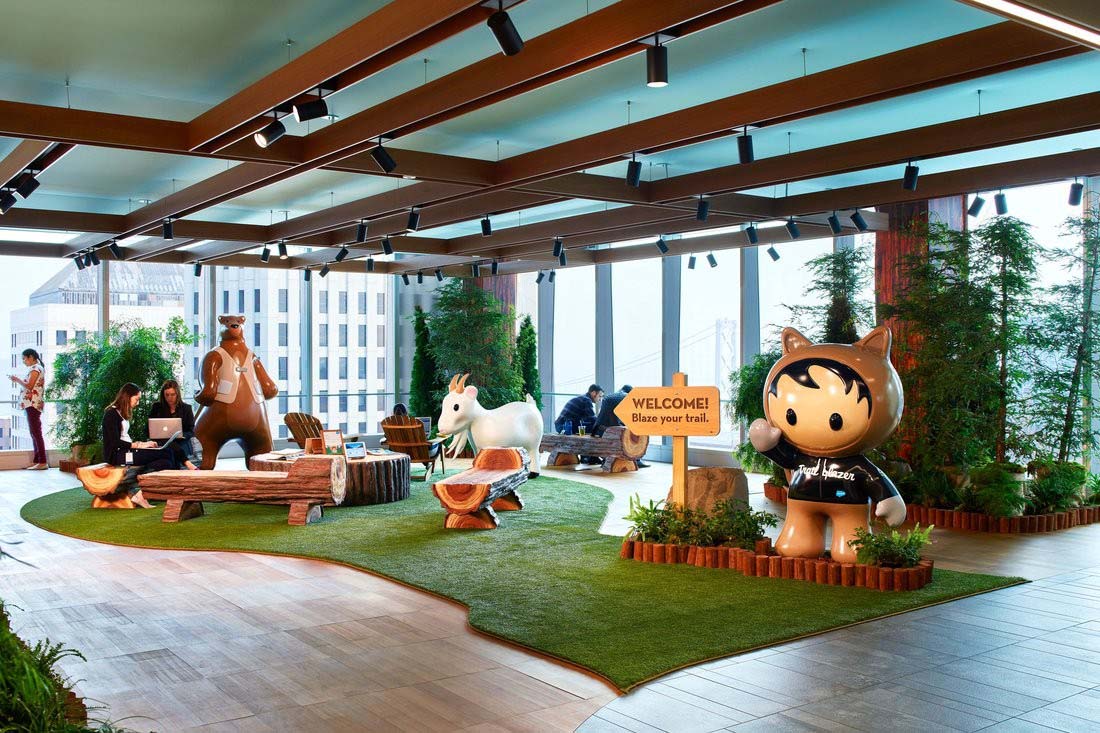
|
Salesforce也承认自身发展比合作伙伴重要,这方面倒是坦诚布公。“我仿佛前世就经历过,”布洛克说,暗示之前在甲骨文的日子。“我们要公开透明,要宣布今后发展的路线图。”布洛克正积极寻找能推动Salesforce进一步增长的领域,带领公司收入从100亿美元增加到200亿美元。“我相信我们能找到属于自己的大蛋糕,然后一口吃下,”他说。“我们会成为《财富》100强里风格独特的公司。想法标新立异,但一定具有可操作性。” 还有个问题就是贝尼奥夫会掌权多久。2015年春天有报道称微软想收购Salesforce。贝尼奥夫称后来之所以进行谈判,都是作为上市公司应对收购要约的责任。报道称,他要的价比微软出价高得多。 我为写这篇文章最后一次见到贝尼奥夫时,他在视频中回答了几个问题,然后准备拍《财富》杂志封面。之前一周他跟我介绍“梦想力量论坛”演讲稿之后,又向亚特兰大和洛杉矶的客户介绍了几个新版本。他就像喜剧演员去大场合演出之前先在小俱乐部彩排一样,打算11月初在旧金山论坛上完美发挥。 当天我们在Salesforce东塔“Ohana”层见面,楼里有个从新Salesforce大厦收集的流浪猫角落。正值秋日,天气原应晴好,但因北部纳帕和索诺玛山火肆虐,天上积满尘烟。采访之前闲聊时,贝尼奥夫对我说他很累。因为家里收养了一只被遗弃的小猫,全家都很兴奋,也都睡不好觉。 贝尼奥夫告诉我,这只7个月大毛色灰黑的暹罗猫之前的主人起了名字,叫“云”。之前可从没人想到这只小生命会进入一位亿万富翁家中,从此享受奢华喵生,而这位富翁正是靠在线买软件,也就是云技术发的家。这故事简直太不可思议,我立刻跟贝尼奥夫开玩笑地说我才不信。当晚他发给我一封邮件,画面中是宠物收容站里小家伙的笼子,外面赫然挂着名字,证明了小猫被他收养之前确实叫“云”。 有些事仿佛冥冥中自有天意。聪明如马克·贝尼奥夫也无法解释。(财富中文网) 本文另一版本将发表于2017年11月1日出版的《财富》杂志,标题为《绽放的贝尼奥夫》。 译者:Pessy 审稿:夏林 |
Salesforce acknowledges that its own growth is more important than its partners, which it excuses by playing the honesty card. “I have seen this movie in a prior life,” says Block, alluding to his Oracle days. “We need to be transparent. We need to publish road maps of where we’re going.” Block is looking after another big-company aspect to Salesforce’s growth, the need to add systems that can take the company from $10 billion in revenue to $20 billion. “I think we can have our cake and eat it too,” he says. “We can be a different Fortune 100 company. We can think differently, but with operational discipline.” Then there’s the question of how long Benioff stays around. In spring 2015 reports surfaced that Microsoft offered to buy Salesforce. Benioff characterizes the ensuing talks as being merely a public company’s fiduciary responsibility to listen to acquisition offers. He reportedly asked for more than Microsoft was willing to pay. I meet with Benioff one last time for this article as he answers a few questions on video and prepares to have his photograph taken for Fortune’s cover. Since he first ran through his Dreamforce presentation for me the previous week he’s presented versions of it to customers in Atlanta and Los Angeles. Like a comedian testing an act in small clubs leading up to a large-venue gig, he plans to repeat the performance multiple times before his keynote address in San Francisco the first week of November. We meet on the “Ohana” floor of Salesforce East, the office tower kitty-corner from the new Salesforce Tower. On what ought to be a stunningly sunny mid-fall day, San Francisco’s skies are clogged with smoke from the devastating wildfires still raging in Napa and Sonoma counties north of the city. Making small talk before we start, Benioff tells me he’s tired. His family has just adopted a rescue kitten, and there is much excitement—and too little sleep—in the Benioff household. As it happens, Benioff tells me, the 7-month-old, gray-black Siamese already had a name, given by his original owners. They called the kitten “Cloud.” This was before anyone could have any idea this little animal was headed for a glamorous life in the home of a billionaire who made his fortune selling software online—what became known as the cloud. The story is too good to be true, and I tell Benioff with mock derision that I don’t believe him. That evening he sends me an email with the subject line “Proof.” Attached is a photo of the sign that hung outside Cloud’s cage at the shelter, verifying his pre-adoption name. Some things just can’t be explained. Not even by Marc Benioff. A version of this article appears in the Nov. 1, 2017 issue of Fortune with the headline “Benioff in Bloom.” |













